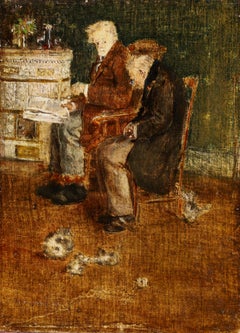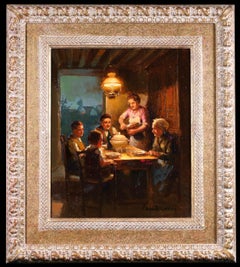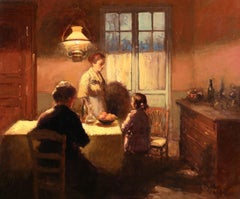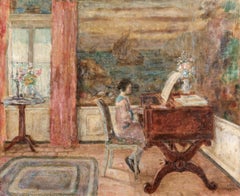Want more images or videos?
Request additional images or videos from the seller
1 of 7
Victor LecomteReading - 19th Century Oil, Man Reading by Lamp in Interior by Victor Lecomtec.1910
c.1910
$4,973.22List Price
About the Item
- Creator:Victor Lecomte (1856 - 1920, French)
- Creation Year:c.1910
- Dimensions:Height: 8 in (20.32 cm)Width: 13 in (33.02 cm)
- Medium:
- Movement & Style:
- Period:
- Condition:Very good condition. Frame has some small losses.
- Gallery Location:Marlow, GB
- Reference Number:Seller: LFA04801stDibs: LU41534792511
About the Seller
5.0
Gold Seller
Premium sellers maintaining a 4.3+ rating and 24-hour response times
Established in 2001
1stDibs seller since 2016
712 sales on 1stDibs
Typical response time: 5 hours
Authenticity Guarantee
In the unlikely event there’s an issue with an item’s authenticity, contact us within 1 year for a full refund. DetailsMoney-Back Guarantee
If your item is not as described, is damaged in transit, or does not arrive, contact us within 7 days for a full refund. Details24-Hour Cancellation
You have a 24-hour grace period in which to reconsider your purchase, with no questions asked.Vetted Professional Sellers
Our world-class sellers must adhere to strict standards for service and quality, maintaining the integrity of our listings.Price-Match Guarantee
If you find that a seller listed the same item for a lower price elsewhere, we’ll match it.Trusted Global Delivery
Our best-in-class carrier network provides specialized shipping options worldwide, including custom delivery.You May Also Like
Looking for Andy Oil on Panel 16" x 10" Framed New Orientalism Artist
Located in Houston, TX
Searching for Andy (Warhol) references woman looking at one of the 199 paintings that Andy Warhol did of Mao. This painting is usually seen in the museum exhibitions around the world Looking for Andy (Warhol) is 16" x 10" and is framed which makes it 20 " x 14" . The artist describes himself as one of the New Orientalists which is a traveling painter in the modern world.
Raj Chaudhuri (b 1967)
My work comes from my life as a human being. I paint what I know and love. Capturing people and their interaction with the environment interests me—be it urban or rural, cityscape or landscape. I strive to find beauty in everyday happenings and how we experience this amazing world in which we live. Growing up in India, I feel my work is enriched by the depth of culture, vibrant colors and energy there. Twenty-three years ago, Colorado became home, giving me a longstanding enjoyment of the mountains, the brilliance of people here and the rich history of the west. I truly enjoy traveling and painting on location; I thrive in painting subjects with which I have a deep connection and understanding of people, structures and landscape.
Art has always been my passion. I found ways to incorporate my artistic abilities in UI design and software development before coming to art full time. To a great extent I find that what like in computer design and now in art is that we are creating abstractions of the real world. There are repeating patterns in how we solve problems in many arenas. The creation of a painting is a technical and visionary problem, with many aspects behind the brushstrokes and values. These challenges underlie the thrill of creating a piece that speaks to viewers, to see what we feel and know about the world around us in art.
To me painting is about finding beauty, balance and something visually engaging. I am fascinated by how light illuminates my compositions. It is different literally in every painting! The design of a painting to me is paramount, and I try and find something beautiful, simple and clear in the composition and then build in layers upon layers of complexity. I want to lead the viewer through a visual journey and have them stay connected to the painting. Art is a way of expressing something deeply personal along with the pure enjoyment of the visual. My goal is to find an interesting design clearly present in each painting, so the viewer sees the abstract visual dialogue that sets up the appealing story of the subject in the painting.
2024
Best of Show Presented by the Coors Western Art Advisory Committee (last image of horse in snow...
Category
2010s American Impressionist Interior Paintings
Materials
Oil, Panel
$1,280 Sale Price
20% Off
H 16 in W 10 in D 0.75 in
"Limelight" Interior Oil Painting of Bar
Located in Denver, CO
Mark Andrew Bailey's "Limelight" is an original, handmade oil painting that depicts an impressionistic interior setting of a restaurant or dining hall.
About the Artist:
Artist Mar...
Category
2010s Impressionist Figurative Paintings
Materials
Oil, Panel
"Keeping it Clean" (2023) by Clyde Steadman, Original Interior Oil Painting
Located in Denver, CO
"Keeping it Clean" by Clyde Steadman (United States) is a handmade interior painting that is unframed, but ready to hang.
Category
21st Century and Contemporary Impressionist Figurative Paintings
Materials
Oil, Panel
$3,250
H 30 in W 24 in D 1.5 in
"Warm Light" (2023) By Riley Doyle, Original Oil Interior Painting
Located in Denver, CO
Riley Doyle's "Warm Light" (2023) is an original, handmade oil painting that depicts a the sun shining through the window. This piece measures at 17 x 14 inches in it's frame and is ...
Category
21st Century and Contemporary Impressionist Interior Paintings
Materials
Oil, Panel
$2,300
H 17 in W 14 in
"Cool Light" (2023) By Riley Doyle, Original Oil Interior Painting
Located in Denver, CO
Riley Doyle's "Cool Light" (2023) is an original, handmade oil painting of an interior. This piece measures at 17 x 14 inches in it's frame and is ready to hang.
Category
21st Century and Contemporary Impressionist Interior Paintings
Materials
Oil, Panel
$2,300
H 17 in W 14 in
"Saint Ignatius Loyola Basking In Light" (2024) by Delton Demarest, Oil Painting
Located in Denver, CO
Delton Demarest's "Saint Ignatius Loyola Basking in Light," completed in 2024, is an oil on panel artwork measuring 6 x 3.25 x 0.25 inches, created on location en plein air. This ori...
Category
21st Century and Contemporary Impressionist Figurative Paintings
Materials
Oil, Panel
$300
H 6 in W 3.25 in D 0.25 in
"Mystery Japanese Frame" (2024) by Delton Demarest, Original Oil Painting
Located in Denver, CO
Delton Demarest's "Mystery Japanese Frame," completed in 2024, is an oil on panel artwork measuring 4 x 6 x 0.25 inches. This original painting featur...
Category
21st Century and Contemporary Impressionist Figurative Paintings
Materials
Oil, Panel
$350
H 4 in W 6 in D 0.25 in
"Sable Poses" (2024) by Delton Demarest, Original Oil Painting
Located in Denver, CO
Delton Demarest's "Sable Poses," completed in 2024, is an oil on panel artwork measuring 3 x 6 x 0.25 inches. This original painting features a restin...
Category
21st Century and Contemporary Impressionist Figurative Paintings
Materials
Oil, Panel
$300
H 3 in W 6 in D 0.25 in
Musicians
By Marc Dalessio
Located in Sag Harbor, NY
American plein-air painter, Marc Dalessio, depicts a band playing at a local tavern. We can tell they are playing folk music because of their instruments, a fiddle (violin), and a ba...
Category
21st Century and Contemporary American Impressionist Figurative Paintings
Materials
Oil, Panel
Light From the Window
By Christopher Clark
Located in Denver, CO
Figure standing with window
Category
2010s American Impressionist Figurative Paintings
Materials
Oil, Wood Panel
More From This Seller
View AllDeux vieillards aux chatons - Impressionist Figurative Oil by J F Raffaelli
By Jean-Francois Raffaelli
Located in Marlow, Buckinghamshire
Signed figures in interior oil on panel by French impressionist painter Jean-Francois Raffaelli. The piece depicts two old men seated in an interior. One is reading his paper as the other naps and there are several kittens on the floor. Painted in the artist's distinctive style.
Signature:
Signed lower left
Dimensions:
Framed: 9.5"x8"
Unframed: 5.5"x4"
Provenance:
Brame & Lorenceau have confirmed the authenticity of this work and it will be included in the digital catalogue raisonne of the painter which is under preparation
A certificate of authenticity fromBrame & Lorenceau accompanies this painting
Private collection - United States
Original artists label verso
Jean-François Raffaëlli's father was a failed Italian businessman and Raffaëlli himself was, among other things, a church chorister, actor and theatre singer. He then studied under Gérôme at the École des Beaux-Arts in Paris. He travelled to Italy, Spain and Algeria and on his return to France settled in Asnières.
In 1876, on a trip to Brittany, he first saw the potential of realist subject matter, if treated seriously. He became involved in meetings of artists at the Café Guerbois, where the Impressionist painters used to gather. As a result, Degas, contrary to the advice of the group, introduced Raffaëlli to the Impressionist exhibitions - according to one uncertain source as early as the very first exhibition, at the home of Nadar, and certainly to those of 1880 and 1881.
In 1904, Raffaëlli founded the Society for Original Colour Engraving. He first exhibited at the Salon de Paris in 1870 and continued to exhibit there until he joined the Salon des Artistes Français in 1881, where he earned a commendation in 1885, was made Chevalier of the Légion d'Honneur in 1889 and in the same year was awarded a gold medal at the Exposition Universelle. In 1906 he was made Officier of the Légion d'Honneur. He was also a member of the Société Nationale des Beaux-Arts. In 1884, a private exhibition of his work cemented his reputation.
He contributed to several newspapers such as The Black Cat (Le Chat Noir) in 1885 and The French Mail (Le Courrier Français) in 1886 and 1887. He published a collection entitled Parisian Characters, which captured his favourite themes of the street, the neighbourhood and local people going about their lives. In 1880 he participated, with Forain, on the illustration of Joris Karl Huysmans' Parisian Sketches (Croquis Parisiens). He also illustrated Huysman's Works. As well as working as an illustrator, he also made etchings and coloured dry-points.
His early attempts at painting were genre scenes, but once he was settled in Asnières he started to paint picturesque views of Parisian suburbs. From 1879 onwards, his subject matter drew on the lives of local people. These popular themes, which he treated with humanity and a social conscience, brought him to the attention of the social realist writers of the time such as Émile Zola. In addition to his realist style, Raffaëlli's dark palette, which ran contrary to the Impressionist aesthethic, helped to explain the opposition of those painters to his participation in their exhibitions. More concerned with drawing than colour, he used black and white for most of his paintings. Towards the end of his life, he lightened his palette, but without adopting any other principles of the Impressionist technique.
After painting several portraits, including Edmond de Goncourt and Georges Clémenceau, he returned to genre painting, particularly scenes of bourgeois life. Later in his career, he painted mainly Breton-inspired sailors and views of Venice. His views of the Paris slums and the fortifications, sites which have almost completely disappeared, went some way towards establishing a genre in themselves and perpetuated the memory of the area: The Slums, Rag-and-Bone Man, Vagabond, Sandpit, In St-Denis, Area of Fortifications. His realistic and witty portrayal of typical Parisian townscapes accounts for his enduring appeal.
Born in Paris, he was of Tuscan descent through his paternal grandparents. He showed an interest in music and theatre before becoming a painter in 1870. One of his landscape paintings was accepted for exhibition at the Salon in that same year. In October 1871 he began three months of study under Jean-Léon Gérôme at the École des Beaux-Arts in Paris; he had no other formal training.
Raffaëlli produced primarily costume pictures until 1876, when he began to depict the people of his time—particularly peasants, workers, and ragpickers seen in the suburbs of Paris—in a realistic style. His new work was championed by influential critics such as J.-K. Huysmans, as well as by Edgar Degas.
The ragpicker became for Raffaëlli a symbol of the alienation of the individual in modern society. Art historian Barbara S. Fields has written of Raffaëlli's interest in the positivist philosophy of Hippolyte-Adolphe Taine, which led him to articulate a theory of realism that he christened caractérisme. He hoped to set himself apart from those unthinking, so-called realist artists whose art provided the viewer with only a literal depiction of nature. His careful observation of man in his milieu paralleled the anti-aesthetic, anti-romantic approach of the literary Naturalists, such as Zola and Huysmans.
Degas invited Raffaëlli to participate in the Impressionist exhibitions of 1880 and 1881, an action that bitterly divided the group; not only was Raffaëlli not an Impressionist, but he threatened to dominate the 1880 exhibition with his outsized display of 37 works. Monet, resentful of Degas's insistence on expanding the Impressionist exhibitions by including several realists, chose not to exhibit, complaining, "The little chapel has become a commonplace school which opens its doors to the first dauber to come along."An example of Raffaëlli's work from this period is Les buveurs d'absinthe (1881, in the California Palace of Legion of Honor Art Museum in San Francisco). Originally titled Les déclassés, the painting was widely praised at the 1881 exhibit.
After winning the Légion d'honneur in 1889, Raffaëlli shifted his attention from the suburbs of Paris to city itself, and the street scenes that resulted were well received by the public and the critics. He made a number of sculptures, but these are known today only through photographs.[2] His work was also part of the painting event in the art competition at the 1912 Summer Olympics. In the later years of his life, he concentrated on color printmaking. Raffaëlli died in Paris on February 11, 1924
Museum and Gallery Holdings:
Béziers: Peasants Going to Town
Bordeaux: Bohemians at a Café
Boston: Notre-Dame; Return from the Market
Brussels: Chevet of Notre-Dame; pastel
Bucharest (Muz. National de Arta al României): Market at Antibes; Pied-à-terre
Copenhagen: Fishermen on the Beach
Douai: Return from the Market; Blacksmiths
Liège: Absinthe Drinker...
Category
1890s Impressionist Figurative Paintings
Materials
Oil, Panel
La Famille - Impressionist Interior Figurative Oil Painting by Edouard Cortes
By Édouard Leon Cortès
Located in Marlow, Buckinghamshire
Signed and titled figures in interior oil on panel circa 1920 by sought after French impressionist painter Edouard Leon Cortes. This charming and nostalgic work depicts a family enjo...
Category
1920s Impressionist Figurative Paintings
Materials
Oil, Panel
Interieur - Effet de Lampe - Impressionist Interior Oil by Edouard Cortes
By Édouard Leon Cortès
Located in Marlow, Buckinghamshire
Signed figures in interior oil on canvas circa 1920 by sought after French impressionist painter Edouard Leon Cortes. This charming and nostalgic work depicts a family in a typical Breton kitchen scene. An elderly lady is seated at the table with her back to the artist and a young girl also sits at the table beside a bowl of oranges and a carafe of red wine. Another lady stands at the table under the light of the lamp.
Signature:
Signed lower right
Dimensions:
Framed: 29.5"x34"
Unframed: 21.5"x26"
Provenance:
Salon des Independants - 1922 exhibition
Galleries Maurice Sternberg - Chicago
Original artists label with title and number "9" on the reverse.
Edouard Leon Cortes, the son of the painter Antonio Cortès, was sent to the front during World War I to sketch enemy positions. In civilian life, his base was in Lagny in the former studio of Cavallo-Peduzzi. Although he travelled extensively in France. Notably in Normandy, Brittany, the Champagne region and Savoy painting...
Category
1920s Impressionist Figurative Paintings
Materials
Canvas, Oil
The Piano Recital - Impressionist Figurative Interior Oil by Frederick Frieseke
By Frederick Carl Frieseke
Located in Marlow, Buckinghamshire
Signed and dated oil on canvas figure in interior painting by American impressionist painter Frederick Carl Frieseke. The piece depicts a young girl in a pink dress seated at a piano...
Category
1920s American Impressionist Figurative Paintings
Materials
Oil, Canvas
A Breton Interior - Impressionist Interior Oil Painting by Edouard Cortes
By Édouard Leon Cortès
Located in Marlow, Buckinghamshire
Signed figures in interior oil on canvas circa 1910 by sought after French impressionist painter Edouard Leon Cortes. This charming and nostalgic work depicts a family enjoying dinne...
Category
Early 20th Century Impressionist Interior Paintings
Materials
Canvas, Oil
Une Ballerine - Realist Figurative Oil Painting by Auguste Leroux
Located in Marlow, Buckinghamshire
Signed oil on canvas figure in interior circa 1930 by French realist painter Jules Marie Auguste Leroux. The work depicts a brunette ballerina wearing a pink tutu and pointe shoes st...
Category
1930s Realist Figurative Paintings
Materials
Canvas, Oil



